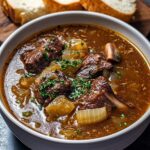The warm, intoxicating aroma of toasted spices, caramelized onions, and seared steak will instantly transport your senses. This Indian-Spiced Pepper Steak is all about fusing quick-cook technique with bold, layered flavor—ideal for weeknights when you’re craving something a little extra.
Rachael Ray’s take on this dish uses real-deal ingredients like fresh chilies, turmeric, garam masala, and a hit of citrus to elevate humble beef steak into a vibrant main dish. Pair it with fluffy basmati rice or grilled naan, and don’t forget a spoonful of mango chutney on the side to balance the spice with sweetness.
Full Recipe:
-
1 1/4 to 1 1/2 lbs beef flank, skirt, or flap steak
-
1 tsp coriander seed
-
1 tsp cumin seed
-
1 tsp mustard seed
-
1 tsp black peppercorn
-
2 tsp chili powder (or 1 tsp cayenne/pepper sauce)
-
1 tsp garam masala
-
1 tsp ground turmeric
-
1 large red onion, chopped
-
1 large red or yellow bell pepper, thinly sliced
-
2 to 3 red/green finger chilies or Serranos, thinly sliced (seeded for less heat)
-
1 inch ginger root, grated or minced
-
5-6 cloves garlic, minced
-
High-temp cooking oil (peanut/safflower)
-
Salt, to taste
-
A few curry leaves (optional but recommended)
-
Juice of 1 lemon OR 2-3 tbsp Shaoxing wine/sherry/apple cider vinegar
-
Handful chopped fresh cilantro
-
Optional: Cooked basmati rice or grilled naan for serving
-
Mango chutney, for serving
Directions:
-
Pat steak dry and slice into strips against the grain.
-
Toast coriander, cumin, mustard seeds, and peppercorn in a dry skillet until fragrant, then grind. Combine with chili powder, garam masala, and turmeric.
-
Heat a cast-iron skillet over high heat. Add 2 turns of oil, then sear beef strips 2–3 minutes per side until browned. Season with salt and remove from skillet.
-
Add another turn of oil, then sauté chopped onion and sliced peppers for 3 minutes.
-
Stir in ginger, garlic, and curry leaves, cooking for another minute.
-
Return beef to the pan, sprinkle with spice blend, toss well, and deglaze with lemon juice or vinegar.
-
Garnish with fresh cilantro and serve with rice, naan, and mango chutney.
Prep Time: 10 minutes | Cooking Time: 20 minutes | Total Time: 30 minutes
Kcal: ~430 kcal per serving | Servings: 4 servings
An Introduction to Indian-Spiced Pepper Steak
Indian-Spiced Pepper Steak is a vibrant, flavor-forward dish that beautifully marries Western cooking techniques with the bold, aromatic essence of Indian spices. Originating as a creative fusion, this recipe takes the familiar comfort of seared beef and elevates it using the complexity of toasted whole spices, the heat of fresh chilies, and the tang of citrus or vinegar. Designed for home cooks looking to spice up their routine, this dish is both easy to prepare and impressive on the plate.
What makes this steak stand out is the layering of flavors at every stage of cooking—from the spice mix and aromatic vegetables to the final drizzle of acid that ties everything together. It’s a true showcase of how simple pantry staples and global inspiration can transform everyday ingredients into a restaurant-quality meal.
The Fusion Behind the Dish
At its core, this dish is a fusion of Indian and Western cuisines. Pepper steak is typically an Asian-American or Chinese-American stir-fry staple, but in this version, it’s reimagined with Indian spices and a slightly rustic approach that echoes street-style Indian cooking. The use of garam masala, turmeric, cumin, mustard seeds, coriander seeds, and freshly ground black pepper gives the steak an unmistakable depth.
The combination of beef with Indian spice is not traditional in many Indian regions where beef is less commonly consumed. However, it’s gaining popularity in modern Indian fusion cuisine, where boundaries between cultural traditions are often deliciously blurred. The balance of earthy, spicy, and slightly sweet flavors reflects a growing global trend toward dishes that honor traditional techniques while welcoming innovation.
Why Toasted Spices Make All the Difference
A defining feature of this recipe is the use of whole spices that are toasted and ground fresh. Toasting spices before grinding awakens their essential oils, releasing complex aromas that dramatically enhance the flavor profile. This small step adds a layer of authenticity and depth that pre-ground spices can’t match.
The spice blend includes coriander seed for a citrusy undertone, cumin for smokiness, mustard seed for pungency, black peppercorn for heat, chili powder for depth, turmeric for warmth and color, and garam masala for an unmistakable Indian signature. Together, they create a deeply flavorful rub that penetrates the meat and clings to the vegetables, delivering flavor in every bite.
The Role of Aromatics and Peppers
Onions, bell peppers, garlic, ginger, and chilies form the aromatic base of the dish. Each ingredient serves a role: onions and bell peppers bring sweetness, garlic and ginger add pungency and spice, while chilies introduce heat. This isn’t just a spicy dish—it’s a symphony of spicy, sweet, tangy, and savory elements.
The type of chili you choose can significantly affect the heat level. Finger chilies or Serranos are recommended for their brightness and manageable heat, but you can adjust the spice level by seeding them or using milder alternatives like jalapeños.
Curry leaves, while optional, bring a fragrant note that’s unmistakably South Indian. When sautéed in oil, they release a nutty, citrusy aroma that lingers on the palate.
Cooking Techniques and Textural Contrasts
The cooking technique is simple but effective. Searing the beef in a cast-iron skillet helps develop a deep crust, locking in juices and flavor. By cooking the meat quickly at high heat, it remains tender and slightly crisped on the edges—a contrast that works beautifully with the softness of the sautéed vegetables.
Stir-frying the onions and peppers after the beef allows them to soften and caramelize slightly without becoming mushy. This texture contrast between tender steak and slightly crunchy vegetables keeps each bite interesting. Once the spices are added and the beef is returned to the skillet, the dish comes together rapidly.
The final step—a splash of acid from lemon juice, vinegar, or sherry—cuts through the richness of the beef and balances the spices. It’s an essential step that brings brightness and rounds out the dish.
Serving Suggestions and Pairings
While the Indian-Spiced Pepper Steak is a complete dish on its own, it shines even brighter when paired with thoughtful sides. The traditional accompaniment is basmati rice, either plain or lightly scented with cardamom, cinnamon, or curry leaves. The long grains of basmati complement the spiced beef, soaking up the juices without becoming soggy.
Grilled naan is another perfect pairing. Its chewy texture and slightly charred flavor provide the perfect vessel for scooping up steak and vegetables. For an extra indulgent twist, brush the naan with ghee or butter before serving.
A small bowl of mango chutney on the side adds a sweet and tangy contrast that cools the palate and pairs well with the bold spices in the steak. Cucumber raita or a simple yogurt sauce would also make a refreshing addition.
For beverages, a lightly sweet or citrus-forward cocktail such as a Mumbai Mule (as suggested in the original recipe) can balance the dish’s spicy profile. Alternatively, a glass of chilled white wine like Riesling or a citrusy IPA could enhance the experience.
Tips for Success and Customization
1. Prep Everything in Advance:
This dish cooks quickly, so having all your ingredients chopped and spices measured beforehand is essential. A mise en place setup helps avoid overcooking or burning spices.
2. Adjust Heat to Taste:
If you’re sensitive to spice, use fewer chilies or opt for milder ones. The recipe is flexible, so it’s easy to tailor to your preferred spice level.
3. Try Different Proteins:
Although the recipe calls for beef flank or skirt steak, it can easily be adapted to other proteins. Chicken thighs, tofu, or even portobello mushrooms make excellent substitutes if you want to keep it vegetarian or leaner.
4. Don’t Skip the Acid:
The finishing splash of lemon juice or vinegar brings crucial brightness. If you want more complexity, try mixing lemon juice with a splash of rice vinegar or apple cider vinegar.
5. Add More Vegetables:
While bell peppers and onions are traditional, you can add snap peas, zucchini, or even baby corn to customize the dish to your liking.
A Dish That Impresses Without the Stress
What makes Indian-Spiced Pepper Steak such a winner is its balance of bold flavor and easy preparation. It’s a dish that feels special enough for a weekend dinner but comes together quickly enough for a weeknight. The aroma of the spices, the vivid color from the turmeric and peppers, and the interplay of heat and citrus make this recipe memorable.
It’s also a fantastic choice for entertaining guests. Serve it family-style with rice, naan, and a few simple sides, and you’ll have a spread that feels luxurious yet approachable. The flavors are bold but not overwhelming, appealing to adventurous eaters and spice lovers alike.
Conclusion: Why You’ll Make It Again and Again
Indian-Spiced Pepper Steak isn’t just a recipe—it’s an experience in flavor. From the crackle of spices hitting a hot pan to the mouthwatering aroma that fills the kitchen, every step builds anticipation. It’s proof that you don’t need complicated techniques or hard-to-find ingredients to create something extraordinary.
The recipe’s flexibility, bold taste, and quick prep time make it a staple for anyone who loves cooking with global flair. Whether you’re trying to recreate a takeout favorite or looking to impress someone with a unique dinner, this dish delivers.
So, next time you’re looking for something exciting yet easy to make, let this Indian-inspired pepper steak spice up your meal—and maybe even your week.





